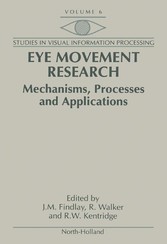Search and Find
Service
Front Cover
1
Eye Movement Research: Mechanisms, Processes and Applications
4
Copyright Page
5
Contents
8
Introduction
6
Contributors
14
PART I: INVITED LECTURES
20
Chapter 1. Eye movements and cognitive processes in reading, visual search, and scene perception
22
Chapter 2. Models of oculomotor function: an appraisal of the engineer's intrusion into oculomotor physiology
42
Chapter 3. The sensing of optic flow by the primate optokinetic system
66
Chapter 4. The functions of eye movements in animals remote from man
82
PART II: PURSUIT AND CO-ORDINATION
96
Chapter 5. Human eye muscle proprioceptive feedback is involved in target velocity perception during smooth pursuit
98
Chapter 6. Variability of sinusoidal tracking characteristics in children
106
Chapter 7. Ocular tracking of self-moved targets: role of visual and non-visual information in visuo-oculo-manual coordination
118
Chapter 8. Eye movements evoked by leg-proprioceptive and vestibular stimulation
128
Chapter 9. Effects of prediction on smooth pursuit velocity gain in cerebellar patients and controls
138
PART III: SACCADE AND FIXATION CONTROL
150
Chapter 10. The relationship between the initial direction and landing position of saccades
152
Chapter 11. Mechanisms for fixation in man: evidence from saccadic reaction times
164
Chapter 12. Saccade latency towards auditory targets
176
Chapter 13. Retinal eccentricity and the latency of eye saccades
184
Chapter 14. Is saccadic adaptation context-specific ?
196
Chapter 15. Fast disconjugate adaptations of saccades: dependency on stimulus characteristics
208
Chapter 16. Visual mislocalization in moving background and saccadic eye movement conditions
220
PART IV: OCULOMOTOR PHYSIOLOGY
232
Chapter 17. A neural mechanism subserving saccade-vergence interactions
234
Chapter 18. Eye position effects on pursuit related responses in area LIP of macaque monkey
244
PART V: CLINICAL AND MEDICAL ASPECTS OF EYE MOVEMENTS
256
Chapter 19. Problems in modelling congenital nystagmus: towards a new model
258
Chapter 20. Eye movement behaviour in human albinos
274
Chapter 21. Smooth pursuit responses to step ramp stimuli in patients with discrete frontal lobe lesions
288
Chapter 22. Smooth pursuit eye movement abnormalities in patients with schizophrenia and focal cortical lesions
300
Chapter 23. Peak saccade velocities, short latency saccades and their recovery after therapy in a patient with a pineal tumor
310
PART VI: EYE MOVEMENTS AND COGNITION
322
Chapter 24. Evidence relating to premotor theories of visuospatial attention
324
Chapter 25. Visual attention and saccadic eye movements: evidence for obligatory and selective spatial coupling
336
Chapter 26. Why some search tasks take longer than others: using eye movements to redefine reaction times
344
Chapter 27. Eye movements and response times for the detection of line orientation during visual search
356
Chapter 28. Chronometry of foveal information extraction during scene perception
368
Chapter 29. Transsaccadic integration of biological motion: overview and further evidence based on reaction times
382
PART VII: EYE MOVEMENTS AND LANGUAGE
398
Chapter 30. A challenge to current theories of eye movements in reading
400
Chapter 31. Effect of luminance and linguistic information on the centre of gravity of words
412
Chapter 32. PP-attachment in German: results from eye movement studies
424
Chapter 33. Individual eye movement patterns in word recognition: perceptual and linguistic factors
440
Chapter 34. Lexical influences on parsing strategies: evidence from eye movements
452
Chapter 35. Effects of a word's morphological complexity on readers' eye fixation patterns
464
Chapter 36. Effective visual field size necessary for proof reading during Japanese text editing
472
PART VIII: DISPLAYS AND APPLICATIONS
484
Chapter 37. Selection by looking: a novel computer interface and its application to psychological research
486
Chapter 38. Eye movement recordings to study determinants of image quality in new display technology
498
Chapter 39. Eye-gaze determination of user intent at the computer interface
510
Chapter 40. Knowledge engineering in the domain of visual behaviour of pilots
522
Chapter 41. Distribution of visual attention revealed by eye movements and neural networks
534
Chapter 42. Gaze control in basketball foul shooting
546
Author Index
562
Subject Index
576
All prices incl. VAT














